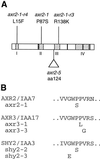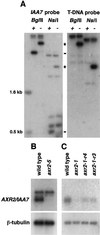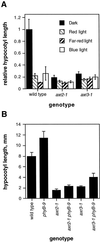AXR2 encodes a member of the Aux/IAA protein family
- PMID: 10859186
- PMCID: PMC59024
- DOI: 10.1104/pp.123.2.563
AXR2 encodes a member of the Aux/IAA protein family
Abstract
The dominant gain-of-function axr2-1 mutation of Arabidopsis causes agravitropic root and shoot growth, a short hypocotyl and stem, and auxin-resistant root growth. We have cloned the AXR2 gene using a map-based approach, and find that it is the same as IAA7, a member of the IAA (indole-3-acetic acid) family of auxin-inducible genes. The axr2-1 mutation changes a single amino acid in conserved domain II of AXR2/IAA7. We isolated loss-of-function mutations in AXR2/IAA7 as intragenic suppressors of axr2-1 or in a screen for insertion mutations in IAA genes. A null mutant has a slightly longer hypocotyl than wild-type plants, indicating that AXR2/IAA7 controls development in light-grown seedlings, perhaps in concert with other gene products. Dark-grown axr2-1 mutant plants have short hypocotyls and make leaves, suggesting that activation of AXR2/IAA7 is sufficient to induce morphological responses normally elicited by light. Previously described semidominant mutations in two other Arabidopsis IAA genes cause some of the same phenotypes as axr2-1, but also cause distinct phenotypes. These results illustrate functional differences among members of the Arabidopsis IAA gene family.
Figures






Similar articles
-
Negative phototropism is seen in Arabidopsis inflorescences when auxin signaling is reduced to a minimal level by an Aux/IAA dominant mutation, axr2.Plant Signal Behav. 2015;10(3):e990838. doi: 10.4161/15592324.2014.990838. Plant Signal Behav. 2015. PMID: 25738325 Free PMC article.
-
Specificity and similarity of functions of the Aux/IAA genes in auxin signaling of Arabidopsis revealed by promoter-exchange experiments among MSG2/IAA19, AXR2/IAA7, and SLR/IAA14.Plant Physiol. 2007 May;144(1):187-96. doi: 10.1104/pp.107.096628. Epub 2007 Mar 16. Plant Physiol. 2007. PMID: 17369427 Free PMC article.
-
Light-dependent gravitropism and negative phototropism of inflorescence stems in a dominant Aux/IAA mutant of Arabidopsis thaliana, axr2.J Plant Res. 2014 Sep;127(5):627-39. doi: 10.1007/s10265-014-0643-1. Epub 2014 Jun 18. J Plant Res. 2014. PMID: 24938853
-
The axr2-1 mutation of Arabidopsis thaliana is a gain-of-function mutation that disrupts an early step in auxin response.Genetics. 1994 Dec;138(4):1239-49. doi: 10.1093/genetics/138.4.1239. Genetics. 1994. PMID: 7896103 Free PMC article.
-
Roles and activities of Aux/IAA proteins in Arabidopsis.Trends Plant Sci. 2001 Sep;6(9):420-5. doi: 10.1016/s1360-1385(01)02042-8. Trends Plant Sci. 2001. PMID: 11544131 Review.
Cited by
-
Negative phototropism is seen in Arabidopsis inflorescences when auxin signaling is reduced to a minimal level by an Aux/IAA dominant mutation, axr2.Plant Signal Behav. 2015;10(3):e990838. doi: 10.4161/15592324.2014.990838. Plant Signal Behav. 2015. PMID: 25738325 Free PMC article.
-
Quantitative phosphoproteome profiling of iron-deficient Arabidopsis roots.Plant Physiol. 2012 May;159(1):403-17. doi: 10.1104/pp.112.193987. Epub 2012 Mar 21. Plant Physiol. 2012. PMID: 22438062 Free PMC article.
-
A receptor for auxin.Plant Cell. 2005 Sep;17(9):2425-9. doi: 10.1105/tpc.105.036236. Plant Cell. 2005. PMID: 16141189 Free PMC article. No abstract available.
-
Benzyl Cyanide Leads to Auxin-Like Effects Through the Action of Nitrilases in Arabidopsis thaliana.Front Plant Sci. 2018 Aug 24;9:1240. doi: 10.3389/fpls.2018.01240. eCollection 2018. Front Plant Sci. 2018. PMID: 30197652 Free PMC article.
-
Expression profiling reveals COI1 to be a key regulator of genes involved in wound- and methyl jasmonate-induced secondary metabolism, defence, and hormone interactions.Plant Mol Biol. 2005 Jul;58(4):497-513. doi: 10.1007/s11103-005-7306-5. Plant Mol Biol. 2005. PMID: 16021335
References
-
- Abel S, Nguyen MD, Theologis A. The PS-IAA4/5-like family of early auxin-inducible mRNAs in Arabidopsis thaliana. J Mol Biol. 1995;251:533–549. - PubMed
-
- Abel S, Theologis A. A polymorphic bipartite motif signals nuclear targeting of early auxin-inducible proteins related to PS-IAA4 from pea (Pisum sativum) Plant J. 1995;8:87–96. - PubMed
-
- Chory J, Peto C, Feinbaum R, Pratt L, Ausubel F. Arabidopsis thaliana mutant that develops as a light-grown plant in the absence of light. Cell. 1989;58:991–999. - PubMed
Publication types
MeSH terms
Substances
Grants and funding
LinkOut - more resources
Full Text Sources
Other Literature Sources
Molecular Biology Databases

